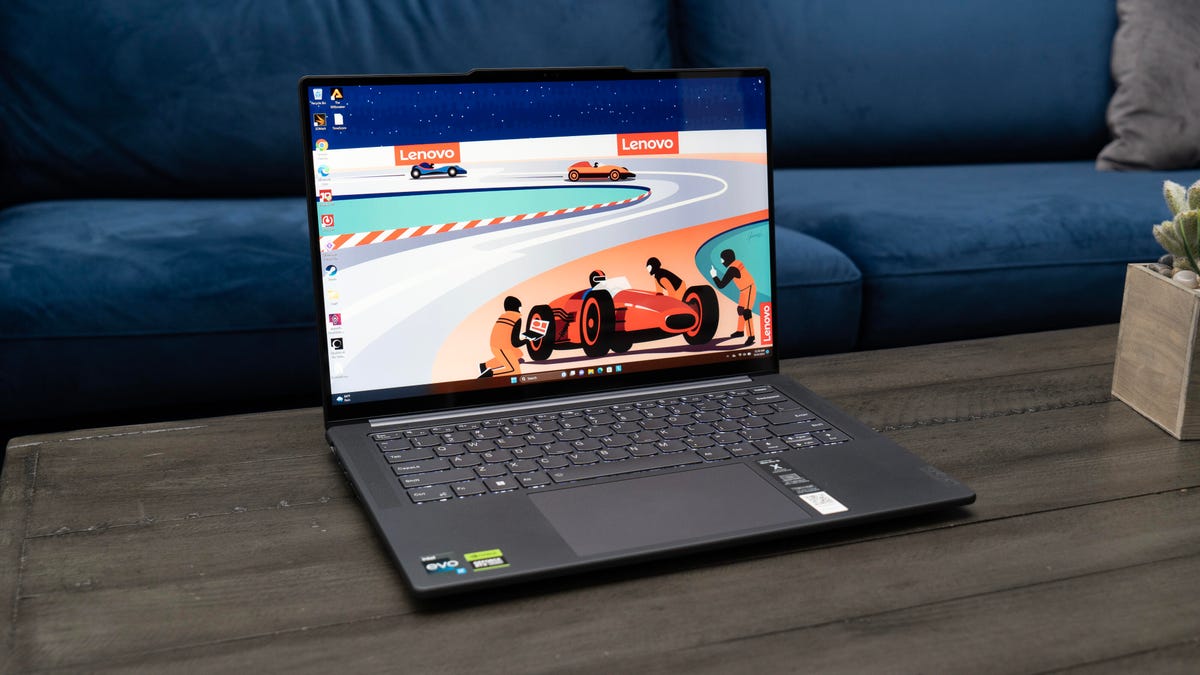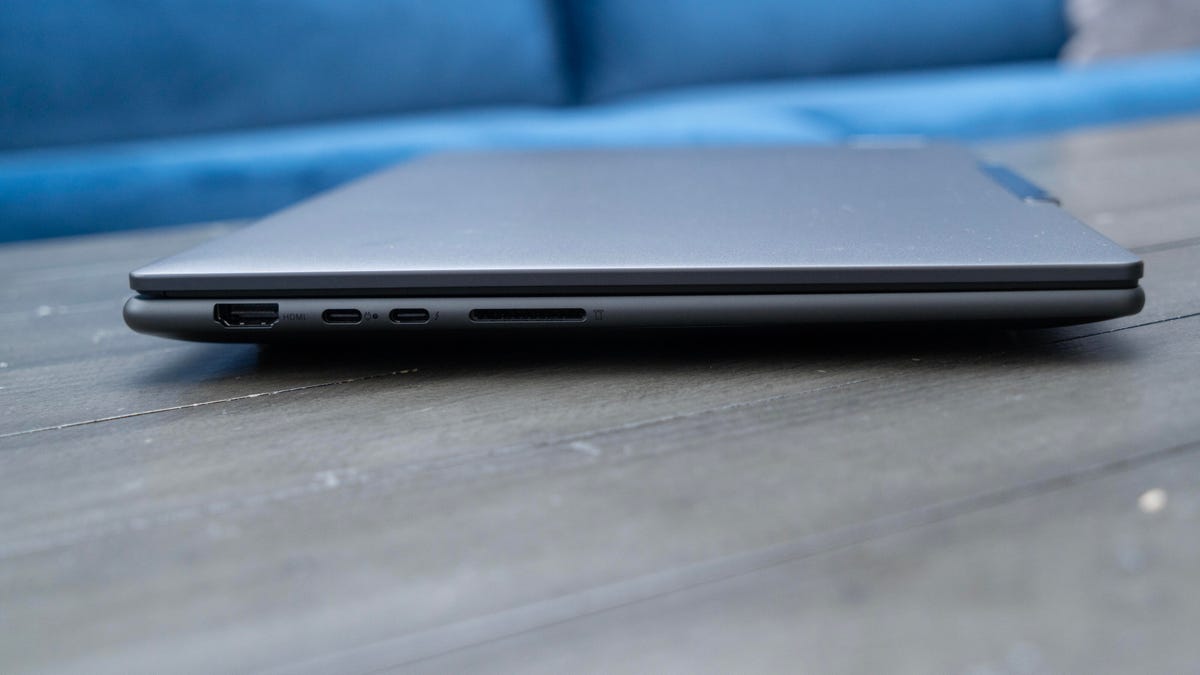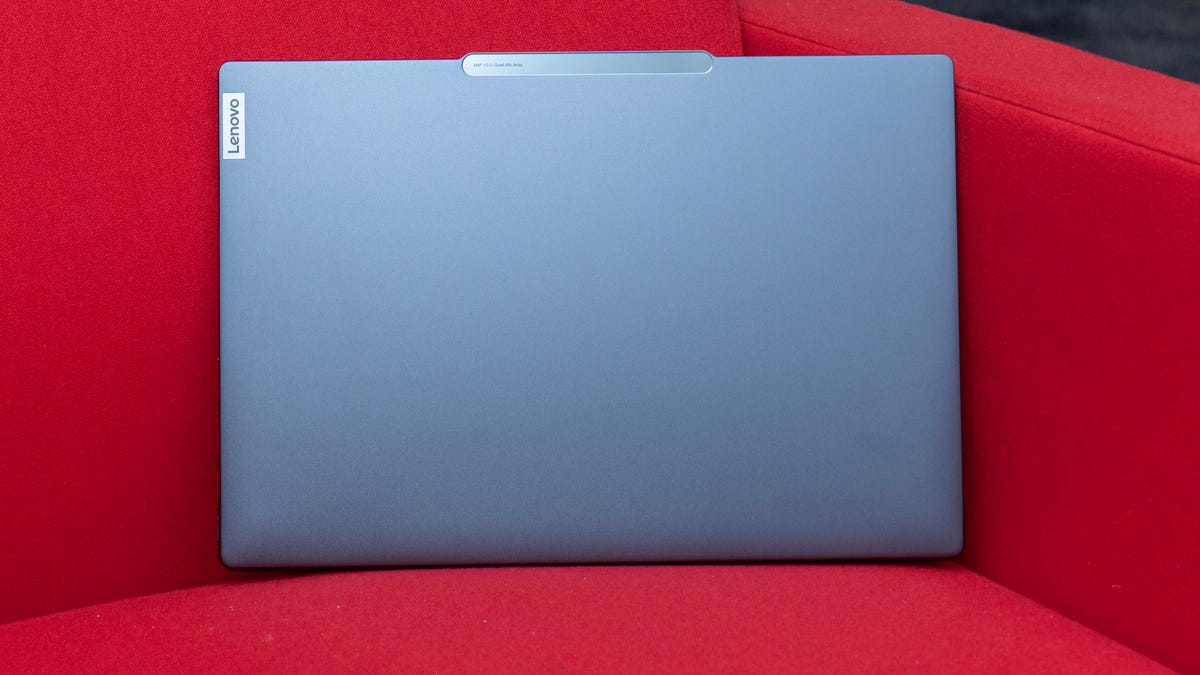Lenovo hits the highlights — literally — with its Slim Pro 9i 14-inch laptop, a creator- and gamer-focused model with a bright HDR screen. The laptop competes with OLED-screen equipped models, like the cheaper Acer Swift X 14, but the Lenovo’s DisplayHDR 1000 mini LED screen holds its own quite well against OLED in HDR thanks to comparable dense blacks and higher brightness than you can get with an OLED screen on a laptop. In SDR, though, it doesn’t fare as well in comparison. Add in the sturdy build, simple but striking design, comfortable keyboard and touchpad, solid performance and excellent sound and it’s a pretty compelling package, if not for people who need.
It also competes with the 14-inch MacBook Pro, which is a lot more expensive once you’ve added memory and storage to match. But it has a screen with similar capabilities.

The 14.5-inch laptop essentially comes in a single $1,800 configuration, equipped with upper midrange processors — Intel Core i7-13705H CPU and Nvidia GeForce RTX 4050 GPU — plus 1TB SSD and 32GB RAM. Lenovo has a lot of similar competitors within its many lines. That’s not cheap, but the screen’s rated 1,200-nit HDR, 600-nit SDR brightness levels and full P3 gamut coverage and 165Hz refresh rate elevate it for creating, gaming and vegetating in front of movies.
There’s also a 16-inch model of the Slim Pro 9i with a step-up configuration of Core i9-13905H and GeForce RTX 4060, plus a 3,200 x 2,000 version of the mini LED display. Although it’s nominally $2,149.
Lenovo Slim Pro 9i (14-inch)
| Price as reviewed | $1,800 |
|---|---|
| Display | 14.5-inch touchscreen, 3,072 x 1,920 165Hz, 250ppi, 1,200 nits HDR |
| PC CPU | 2.4GHz Intel Core i7-13705H |
| PC Memory | 32GB LPDDR5-6400 (soldered) |
| Graphics | 6GB Nvidia GeForce RTX 4050 |
| Storage | 1TB NVMe SSD, SD card slot |
| Ports | 2 x USB-C (1 x Thunderbolt 4), 2 x USB-A, 1 x combo audio, 1 x HDMI 2.1 |
| Networking | Intel Wi-Fi 6E AX211, Bluetooth 5.3 |
| Operating system | Windows 11 Home (22H2) |
| Weight | 3.7 lb/1.7 kg |
Lenovo doesn’t skimp on the ports, which are more plentiful than you typically see on a laptop this size. If you’re picky about which side the charger connects on, righties are out of luck; both of the USB-C/Thunderbolt ports are on the left. But the two USB-A ports are on the right if you need to connect older keyboards or mice. Plus, it has an SD card slot, which is convenient, and an HDMI connector for monitors that don’t have USB-C or when you don’t have your USB-C-to-HDMI adapter.
It also feels solidly built, with a matte gray finish and slight protrusion at the top where the webcam and IR cam (for Windows Hello) sit. The webcam is just okay; it’s 5MP, but the quality doesn’t stand out and it has a fixed field of view and focus. The mic array picks up sound and processes out background noise very well, but it also sounds like it’s been processed — a little bit of the talking-in-a-tunnel effect.

All of these add up to a slightly thicker and heavier laptop than a lot of competitors; for instance, it’s 0.8 inch (21mm) and the MacBook Pro 14 is only 0.6 inch (15.5mm).
Performance
The Slim Pro 9i delivers average to above average performance. The CPU falls exactly in line with all Core i7-13700H laptops we’ve tested (the 13705H is essentially the same chip), and the GPU runs about the same as the other RTX 4050 systems of similar size; bigger systems, like the 16-inch Samsung Galaxy Book 3 Ultra, can usually push it more thanks to extra room for cooling. But the Lenovo also has the ability to overclock the GPU and the video memory — a capability usually exposed only in gaming systems, not primarily creative ones.
Simply turning on the overclocking in Lenovo’s Vantage software and leaving it at its default values yielded a surprising bump in frame rates, in both games and pro graphics software; enough of a bump to push its performance up to RTX 4060 levels. The fans do kick in, and it can get a bit loud, though, and performance can get inconsistent as it frequently throttles back when it hits the thermal ceiling.

In HDR mode, it looked extremely good. Because the tiny size of the mini LED array elements and the local dimming, it can deliver effectively zero-nit blacks — below the 0.018-nit threshold of my colorimeter, at least and visually barely detectable. All sorts of content looked terrific. The one drawback is that it’s profiled for the default system brightness setting (40), but the brightness control isn’t locked down the way it needs to be in HDR, and if you increase it, the HDR can get thrown off, hitting peak brightness too early and then just clipping it.
In standard mode, it’s less impressive. According to Lenovo, mini LED backlights make it harder to calibrate, which is probably true to some extent. And mini LED is really intended for HDR with local dimming, which SDR doesn’t use. But this also uses a TCL-owned CSOT panel, and its TVs also show increasing skewing as grays go from black to white. Here, it means as brightness/whiteness increases, the red channel gets boosted way too much and the blue way too little, resulting in a visible red-yellow cast (that low white temperature).
Display measurements
| Preset | Gamut (% coverage of relevant gamut) | Predominant color temperature | Gamma | Peak brightness (nits) | Accuracy (DE2K average/max) |
|---|---|---|---|---|---|
| sRGB | 100% | 5,350K | 2.19 | 658 | 3.9/10.5 |
| D65 P3 (default) | 97% | 5,300K | 2.19 | 660 (136 at default setting) | 3.9/10.6 |
| Adobe RGB | 72% | 5,400K | 2.19 | 654 | 4.12/10.85 |
| D65 P3 HDR | 99% | roughly 6,000K; darkest blacks and brightest white throw the calculation off | n/a | 1,407 | n/a |
| D65 P3 (after calibration) | 89% | 6,300K | 2.3 | 524 | 1.2/5.9 |
After calibration, it gets a lot better, sort of. It’s forced to pull back the red channel, which means peak brightness drops and it has a little more trouble hitting the target values in the shadows (hence the 2.3 gamma rather than 2.2). But pulling back the red decreases the P3 gamut coverage a lot; it falls quite short of the saturated red primary that defines the corner of the P3 gamut. And it means the defined color space presets that can access in the Vantage utility aren’t very useful.
At the default brightness, it’s too dim for everyday use, so you may likely have to bump it up for comfortable viewing (to 50 or 60). That cuts back on battery life, though. And like all Windows laptops, I suggest you turn off the autobrightness adjustment. It’s designed to save battery and compensate for big changes in ambient lighting — like going from indoors to outside — but I find that the brightness changes either too often or not often enough, as well as too randomly and very obviously (not gradually enough). Plus, the light sensor picks up changes only when the light source is behind you or if it’s really bright out. So it’s more distracting than useful. Your mileage may vary, of course.
And speaking of battery life, it’s pretty so-so. On our streaming video tests it makes it to about 8.2 hours, but that’s really the outside you can expect to see.
I like the Lenovo Slim Pro 9i a lot, which makes the color accuracy issues more disappointing than they might otherwise be. But if you’re willing to do your own calibration and don’t care about the contraction of the P3 color space when you do, then it’s quite a nice option.
Geekbench 6 (multicore)
Cinebench R23 CPU (multicore)
Streaming video playback battery drain test (minutes)
Shadow of the Tomb Raider gaming test (1080p)
3DMark Time Spy
Guardians of the Galaxy (High @1920 x 1080)
SpecViewPerf 2020 SolidWorks (1080p)
Configurations
| Apple MacBook Pro 16 (2023) | Apple MacOS Ventura 13.2; Apple M2 Pro (12 CPU cores, 19 GPU cores); 32GB LPDDR5 RAM; 1TB SSD |
|---|---|
| Dell Inspiron 16 Plus 7630 | Microsoft Windows 11 Home; 2.4GHz Intel Core i7-13700H; 16GB DDR5 4,800MHz RAM; 8GB Nvidia GeForce RTX 4060 graphics; 1TB SSD |
| Lenovo Slim Pro 9i (14-inch) | Microsoft Windows 11 Home; 2.4GHz Intel Core i7-13705H; 32GB DDR5 6,400MHz RAM; 6GB Nvidia GeForce RTX 4050 graphics; 1TB SSD |
| Microsoft Surface Laptop Studio 2 | Microsoft Windows 11 Home; 2.9GHz Intel Core i7-13700H; 64GB DDR5 5,200MHz RAM; 8GB Nvidia GeForce RTX 4060 graphics; 1TB SSD |
| Samsung Galaxy Book 3 Ultra | Microsoft Windows 11 Home; 2.4GHz Intel Core i7-13700H 16GB DDR5 6,000MHz RAM; 6GB Nvidia GeForce RTX 4050 graphics; 1TB SSD |

